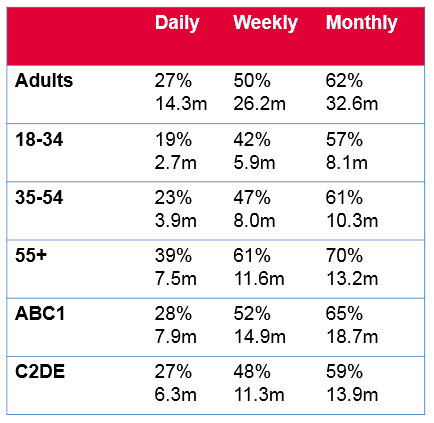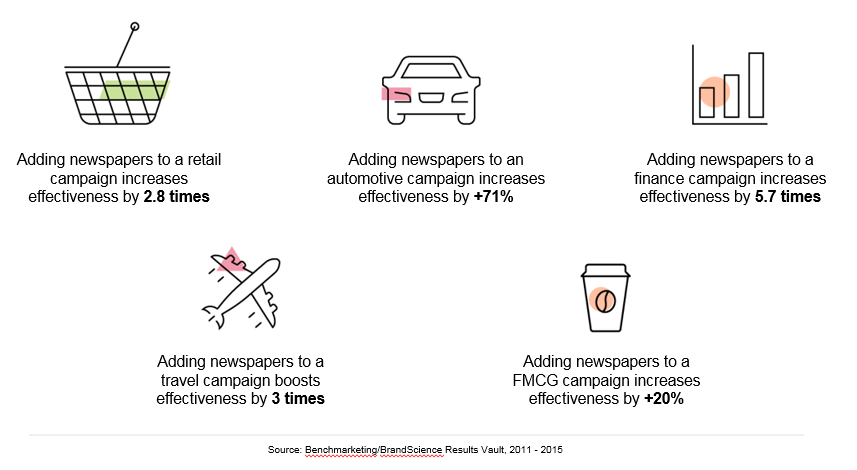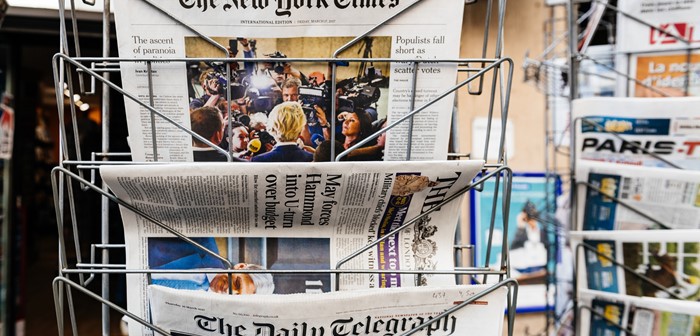It has long been perceived that Print is a dying media. Common perceptions that the media is in decline is usually due to comparisons of its heyday in the latter half of the 21st century. To some extent they are right. Print certainly is not the labyrinth it once was, however, with UK ad spend remaining robust across all other media, it seems strange that Print has suffered a disproportionate 9% decline in YoY spend (Ebiquity) vs. just a 4% decline in total circulation (ABC).
Are clients and media agencies right to reduce spend beyond its decline in reach?
Reach

Source: NRS Apr16 – Mar17
It is no secret that circulations have been in decline, but it should not be ignored that newspapers alone still offer daily reach of 14.3m (NRS PADD). To put this into perspective, the most watched one off TV show on commercial channels in 2016 was I’m a Celeb with 12.3m impacts.
If you look at audience monthly reach, Print increases its overall audience to 32.6m, 62% of the total adult population of the UK.
Audience
There are common misconceptions over Print audience. Print is perceived as only reaching the older population. Whilst it certainly does reach this audience (13.2m 55+ monthly), there is a healthy distribution of reach across all age ranges and demographics.
There is continued pressure on clients to target millennials, who are notoriously difficult to interact with, but by utilising Print, they will immediately have access to up to 8.1m 18-34s.
What we mustn’t dismiss are the revenue opportunities that Baby Boomers have to offer. The disparity of wealth is ever growing with Boomers benefiting from paid mortgages, increased housing prices and high-interest pension schemes. That combination results in disposable income which clients should be looking to take advantage of. There is also the consideration that more luxurious millennial purchases (cars, holidays etc.) are financed by the older generation. As a result, it is imperative to stay front of mind across both audiences, particularly during the decision-making process. Print offers the perfect platform to reach these audiences simultaneously.
Engagement
What is often forgotten is that the majority of Print products in the UK are purchased. This means that consumers have actively gone out of their way to interact with their title of choice. As a result, the audience is highly engaged with the product. Average dwell time far exceed its media counterparts with newspapers seeing daily dwell times of 69 minutes (and 87mins on Sunday). Magazines see similar performances, and in some cases, increases in dwell times dependent on sectors.
Effectiveness

A recent study by Newsworks assessed the optimum portion of budget that should be allocated in Print to generate the greatest ROI for the client. The study, comprising of 500 various econometric data sets, showed that implementing newspapers into campaigns boosts ROI by 3 times on average. Furthermore, campaigns involving Print boost other media, with TV twice as effective and Digital four times more effective.
So IS Print underutilised?
In a word.
YES!
Print is in an extremely healthy condition despite recent declines. If anything Print has been forced to get smarter as a result, with a more loyal and influential audience consuming its media on a daily basis.
There are many opportunities to engage with multiple audiences in a pragmatic and trustworthy manner that few other media channels could offer on a real time basis. With reams of research to take advantage of, there are ample opportunities to utilise Print either to complement or enhance campaigns to gain client greater influence and more cost efficient ROI.




